They say… 
Best beer and travel writing award 2015, 2011 -- British Guild of Beer Writers Awards
Accredited Beer Sommelier
Writer of "Probably the best book about beer in London" - Londonist
"A necessity if you're a beer geek travelling to London town" - Beer Advocate
"A joy to read" - Roger Protz
"Very authoritative" - Tim Webb.
"One of the top beer writers in the UK" - Mark Dredge.
"A beer guru" - Popbitch.

|
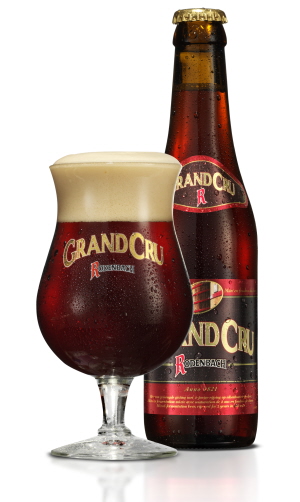 Rodenbach Grand Cru Top Tastings 2012
ABV: 6%
Origin: Roeselare, Oost-Vlaanderen
Website: www.palm.be
Beer writers and experts tend to have different drinking habits from ordinary beer drinkers. To keep ourselves well informed and authoritative, we’re usually tasting beers we haven’t tried before, and find ourselves passing on the popular and familiar by. In contrast, while the number of discerning consumers prepared to experiment is growing, most people still turn to established favourites as their fall back position without the compulsion of novelty.
Of course all beer writers worth their salt have tasted the revered classics and style-defining benchmarks – but it might have been years ago, when they were honing their skills and expertise by ticking their way through Michael Jackson books. It’s a tendency I’m now trying to balance out, making a conscious effort to return with the benefit of experience to the sort of beers that sent me out on this adventure in the first place.
So it was that when on a pub review visit to Belgique Bistro, a Belgian-themed tea room and bar in the unlikely location of leafy Wanstead, last summer, I siezed the opportunity to revisit Rodenbach Grand Cru, one of the beers I used to consider a touchstone of my enthusiasm.
Rodenbach is the most prominent surviving producer of Flemish oud bruin, sometimes known in English, following Jackson, as sour red ale. The brewery’s base beer is made with Vienna malt added to the grist, which partly explains the reddish hue, and also contains a proportion of corn grits and sugar. The last time I saw the hop varieties listed they included German Brewers Gold and Kent Goldings.
It’s what happens after mashing and boiling, though, that’s most interesting. The wort is fermented with a multistrain yeast which includes lactic microorganisms contributing a lightly sour taste. It’s then matured for up to two years in a hall full of 300 giant wooden vats known as foeders, made of Slavonian oak from Poland.
These vessels vary in capacity from 12,000l to 65,000l and some of them are more than 150 years old. Each one has its own resident menagerie of microflora that adds still more complexity to the beer, including funky wild yeast notes of the sort that only appear during long maturation, which also deepens the colour still further.
To create the final product, old and young beers from various selected foeders are blended together – the standard Rodenbach uses a 50:50 mix but the more intense, and stronger, Grand Cru includes two thirds of older beer. Bottles and kegs are then flash pasteurised and sent out brewery conditioned, though some vintage specials of mature beer from individual foeders have been bottle conditioned.
Brewery historians will instantly recognise the similarities between Rodenbach’s production and classic 18th century London porter brewing, even down to the blending of ‘stale’ and ‘mild’ beers – and to the production of old and stock ales that just about clings on in England at, of all places, Greene King (see Old 5X).
The Rodenbach family, originally from Koblenz in Germany, first got involved in brewing in Roeselare in 1832, and it’s sometimes said that one of the family, Eugene Rodenbach, learned the techniques in eastern England in the 1880s. However, brewing has been a relatively international occupation at least since it first became a large scale industry, and brewers often independently evolved similar responses to similar challenges, such as keeping beer reliably consistent and palatable without refrigeration and microbiological science to help.
Whatever the truth, Rodenbach today is something of a brewing heritage treasure. In 1998 it was bought by Belgian national brewer Palm and there were intial concerns this might spell the beginning of the end for its unique products, but in fact the parent company has invested and now proudly promotes the beer as a revered regional speciality.
Opening my Grand Cru, I rediscovered a deep chestnut brown beer with a reddish tinge, and a light beige head that left soft lace on the glass. The aroma was immediately familiar and distinctive – sharp with orange citrus and balsamic qualities, and a hint of minerals and iron, the latter leading on to a suggestion of blood.
The palate was also intense and notably sour with a complex acidity layering very full fruity and chocolate notes. A refreshing swallow left a lightly acidic trace, with funky woody notes, more chocolate and a perfumed touch reminiscent of lemon and honey permeating a long finish.
The beer remains an enduring classic, and one I personally delight in, though it’s unarguably an acquired taste. When I presented it at a recent private beer tasting for a corporate client, it divided the room. Like lambic, it seems the keenest conventional beer drinkers are often the most challenged, while those who believe they don’t like beer can find it refreshing and beguiling.
 Mikkeller Big Worse Barley Wine (Proef) Top Tastings 2012
ABV: 12%
Origin: Lochristi, Oost-Vlaanderen
Website: mikkeller.dk
Highly creative and prolific Danish cuckoo brewer Mikkel Borg Bjergsø will need no introduction to craft beer connoisseurs. His preconception-challenging products have cut a swathe through the world of beer appreciation since his kitchen home brews first went on sale at a København shop in 2005, and have helped shift the international discussion of beer to a new level.
Mikkel brews a huge range of beers including in more sessionable styles, but he’s best known for the big strong stuff, often inspired by Belgian or historic British models. Much of the beer is made at the reliable Proef brewery in Lochristi, Belgium, many a would-be brewing warrior’s facility of choice for progressing domestic experimentation to the commercial level.
Big Bad Worse Barley Wine, a stronger successor to the earlier Big Bad Barley Wine, is one of the best Mikkeller beers I’ve tasted yet. It’s brewed from pilsner and caramunich barley malt, with added candy sugar, and a blend of Nugget, Cascade and Centennial hops.
The beer pours a cloudy burgundy colour with a thick yellowish-fawn head. A prominent and very complex aroma has notes of pine, figs, tobacco ash and malt loaf with a delicate fruity waft.
The palate is sweet but well balanced by delicate dryness, with dark candied citrus peel, apricot fruit and piny, herbal edges. A slowly drying citric finish turns quite chalky and mineral-tinged with fresh nuts, and hops forming a bitter nugget amidst smooth, syrupy mouth-coating malt.
This isn’t a weird beer – in many ways it’s a very straightforward and traditional interpretation of the style, though brilliantly accomplished to produce an immensely complex and exquisite glassful.
I bought a bottle with an April 2016 best before date at the always reliable Kris Wines, London N7, as a seasonal treat for myself in December 2012 and it turned out to be a perfect choice. Although more than ready to drink, it would also be worth cellaring.
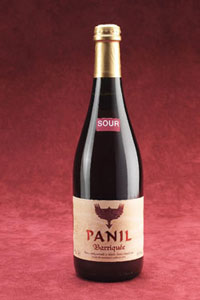 Panil Barriquée Sour Top Tastings 2012
ABV: 8%
Origin: Torrechiara, Emilia-Romagna, Italy
Website: www.panilbeer.com
Italian craft brewers and drinkers seem to have taken easily to perceiving beer through a similar mindset to that used for wine. It’s an artisanal product with a definite provenance, served with food from attractive 750ml bottles. Some of it even contains grape must. And to underline the affinities even further, there’s Barriquée, a rather vinous beer with a label that even references classic wine label design, made on a vineyard by the scion of a winemaking family.
The Losis had been making Lambrusco-style wines at Torrechiara, near Parma, since the 1930s when, in 2001, Renzo Losi, already a home brewer, started making beer under the Panil name as an offshoot of the family business. A year later Renzo became almost certainly the first Italian craft brewer to experiment with barrel ageing, creating Barriquée, named with a French word for a small wooden barrel.
His inspiration was sour, aged Flemish red ale in the style typified by Rodenbach – which was once known to promote itself with the slogan “´t is wijn”. These beers are sometimes labelled the Burgundies of Flanders and some of them, like Timmermans’ Bourgogne des Flandres, have even adopted brand names accordingly.
There’s a mild version too, but I was particularly interested to try the sour, which is brewed from English, Belgian and German pale and coloured barley malts with Czech and German hops and fermented both with ale yeast and lactobacillus. After spending 15 days fermenting in steel vessels the beer spends 90 days undergoing a secondary fermentation in small French oak barrels formerly used for Cognac or Burgundy.
It’s then bottle conditioned and retained at the brewery for a further 30 days before release. As you’d expect the flavour varies and there are some complaints online of lack of consistency, but I had no problems with the 2012 vintage I bought at the excellent brewery shop at De Molen in Bodegraven, the Netherlands.
My sample poured a dark red-brown with a creamy fawn head tinged with light pink. A very funky aroma had notes of farmyard, pencil lead, chocolate, condensed milk, light toffee and cherry fruit.
A soft and lightly cakey palate immediately turned tart, the intensity softened by complex flavours of cherry fruit, red wine, juicy tangerine, chocolate and spicy tobacco. Smooth alcoholic warmth offset the lactic tartness in a refined and elegant finish with soft citrus fruit and wine-like tannins.
The beer has something of a cult following in the US and at one point two versions of the sour were produced, with the export version sourer than the domestic one, though recently there’s only been the one. Interestingly the US is also home to another celebrated craft brewer that developed from a winery – Russian River – which shares an interest in Belgian-inspired and wood aged beers.
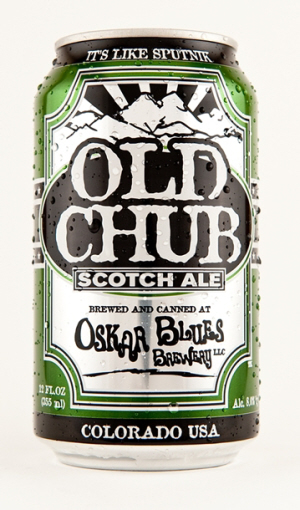 Oskar Blues Old Chub Scotch Ale Top Tastings 2012
ABV: 8%
Origin: Longmont, Colorado, USA
Website: www.oskarblues.com
2012’s annual British Guild of Beer Writers reception on the eve of the Great British Beer Festival could almost have been tailor made to antagonise some of the more purist supporters of the festival itself – for its theme was not only American craft beer, but American craft beer in cans. Held downstairs at Covent Garden’s Porterhouse, it was sponsored by US trade organisation the Brewers Association, and featured 17 beers from half a dozen brewers.
A few CAMRA stalwarts could be seen among the crowd enjoying the offerings like everyone else. And quite right too, as the received wisdom about canned beer has long become technologically outdated. Modern cans don’t taint the flavour of the beer, but they do protect it, being more airtight and better at blocking potentially damaging ultraviolet light than even brown bottles.
The claim that they’re more environmentally friendly is debatable, as the raw material extraction is more damaging and the manufacture more energy intensive than glass bottles, particularly if the latter are recycled, but they’re unarguably a lot lighter to transport and more efficient to store. Some brewers – for example New Belgium and Sierra Nevada – are now even conditioning in cans, though the examples served at the Porterhouse were all filtered.
The wide range of styles and strengths on offer at the event – from brewers including 21st Amendment, Caldera, Maui and Ska – included some excellent beers and any issues with the less impressive examples were clearly not attributable to the packaging. Of all those I tried, my particular favourite was Oskar Blues’ strong, soft and comforting Old Chub.
Oskar Blues claims to be the first US craft brewer to can its own beer. The main plant is now in Longmont, Colorado but the brewery was originally launched in 1998 in the cellar of Dave Katechis’ restaurant in Lyons. When it started packaging beer in 2002 it went straight to cans, never bottles. The first beer to receive the treatment was the strong and hoppy but well balanced Dale’s Pale Ale, still its flagship. But Old Chub has also turned the heads of critics and beer judges.
Subtitled “Scotch Ale”, Old Chub clearly takes its cue from strong 90/- wee heavies, but there’s some beechwood smoked malt in there alongside the pale and crystal. Presumably the brewer was aiming to reference whisky – except that whisky malt was never a feature of traditional Scottish beer styles, and smoking malt over beechwood is more the habit of Bamberg brewers than Speyside distillers.
No matter, as the resulting beer is nonetheless delicious. It’s a warm red colour, with a thick beige head and a rich and creamy aroma. The smoked malt isn’t at all intrusive – instead there are notes of red wine, chocolate, peppery spice and meringue.
A soft, sweet and slightly vinous palate has plenty of cakey malt and marzipan but steers clear of cloying, with toasty and spirity notes and even a hint of mint. A lightly toasty and very satisfying finish lingers with fruit and malt flavours and a sweetly alcoholic touch. Definitely a “book at bedtime” beer.
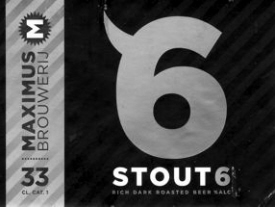 Maximus Stout 6 Top Tastings 2012
ABV: 6%
Origin: Utrecht, Netherlands
Website: www.brouwerijmaximus.nl
My first visit to the Borefts Bierfestival at De Molen brewery in Bodegraven in September afforded me a chance to hang out in Utrecht for the first time in a few years – and unsurprisingly I kept bumping into beer bloggers and tweeters. This handsome cathedral and university city has a good few decent beer pubs, and Kafé België and Café Derat (the latter with an excellent lambic list, incidentally) were the ones that particularly drew us.
These outlets now also have a good new local brewery to support. Ewald Visser and Arend-Jan Van Dieën, former managers of Kafé België, first sold contract brewed beers under the Maximus name in 2011, but since early 2012 have been brewing at their own facility and tasting room in the city’s western suburb of De Meern, using a second hand 15hl brewhouse originally at the Hibernia brewery in Gelsenkirchen, Germany.
Maximus, according to its website, sets out to brew the sort of beers the brewers themselves like to drink – “drinkable but with a surprise in every mouthful”. Like several other Dutch breweries, the company also has social objectives, offering training to school leavers and people with long term health conditions.
Two stouts are brewed, at 6% and 8%, and I sampled the weaker one on keg at België following numerous recommendations from the assembled enthusiasts. This very dark brown beer had a foamy beige head and a notably smoky, leathery aroma with an oily chocolate note.
A smooth and very firm palate was slightly sweet, subtly balanced and gently fruity with pipe tobacco notes. A dab of ashy, roasty flavour offset things perfectly. Cherry and blackcurrant fruit showed up on a relatively short but well integrated finish, with more of that tobacco and ashy roast.
The brewers have certainly achieved their stated ambition with this one, which had lots going on at every stage, but all of it in perfect harmony.
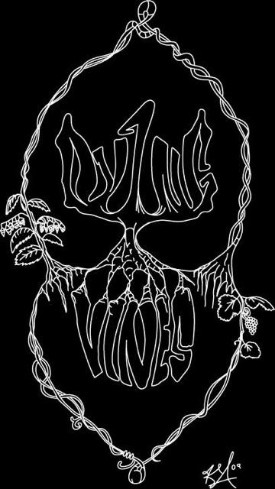 Dying Vines brewery, Oakland, California Top Tastings 2012
ABV: 4%
Origin: Oakland, California, USA
Website: dyingvines.com, lindenbeer.com
One interesting facet of my most recent visit to California in October 2012 was the obvious growth of interest among craft brewers in cask conditioned beer. Numerous bars I visited were sprouting a couple of handpumps or a firkin or two on stillage, and judging by the overall quality the cellar staff seemed to have improved their skills in dealing with the stuff.
As a British beer connoisseur whose tastes were formed in the CAMRA era, I can’t help finding the sight of an Angram beer engine cheering. But it also has to be admitted that many of the signature styles of the US craft beer movement don’t always work so well at the lower carbonation and warmer temperatures of a classic cask ale. So what’s also noteworthy is that a complementary interest in the sort of delicate, low gravity session beers that work well in cask appears to be growing too.
To me, mild is the ultimate cask beer style. A descendant of the original ‘running ales’ that ousted the aged, ‘stale’ flavours of porter in popularity, it flourished as a proletarian refresher in the Victorian industrial heyday. A good mild is an excellent showcase of the brewer’s skill. Exhibiting depth of flavour and character at a gravity perfect for easy, sociable drinking, it best expresses its subtlety at cellar temperature and with the gentle carbonation of a natural secondary conditioning in an unpressurised cask.
Previous tastings of North American milds were chilled and gassy experiences leading me to conclude that brewers across the Atlantic hadn’t quite got the point of the style. But the sample of Dee’z English Mild I tasted on cask on my last visit was something else entirely.
It wasn’t just the best US cask beer I’ve sampled so far, it was one of the very best cask milds I’ve ever encountered. And as for many years my regular strategy at a British beer festival is to start by hitting as many milds I haven’t yet tried as I can find, that’s not an insignificant assessment.
The beer was a deep brown colour with a smooth fawn head. A lightly inky, toasty aroma had notes of caramel and very gentle roast. The palate was smooth, rich and very authentic, malt accented but lightly roasty with light but kind caramel, gently tangy fruit hints, an emerging slightly pursing dryness and a restrained hop bite.
Chocolate showed up in an easy malt finish that developed smooth, fudgy notes over very gentle but cheering roast and a late hint of charcoal. Overall the beer was very well integrated and moreish.
It’s brewed by Kellen Alcala, who now moonlights as a professional brewer alongside his day job in a homebrew supplies shop in Berkeley. Kellen set up Dying Vines deliberately to pursue a largely British-inspired interest in session beers, and Dee’z, named after his wife, was his first product.
He brews at Linden Street brewery in Oakland, which itself focuses on relatively modest and everyday styles, producing old fashioned pre-Prohibition lager and California common beer. Oakland, just across the bay from San Francisco, was a major industrial brewing town before the passing of the 18th Amendment, and operations like Linden Street and Dying Vines are spearheading a modest revival.
The Abbot’s Cellar in San Francisco’s Mission District, where I tried Dee’z, is an upmarket restaurant that must be one of the poshest beer destinations in the Bay Area, so there was a certain irony in enjoying a mild in such well heeled surroundings. Quite what language the $8 (£5.30, €6,25) a (small American 160z/473ml) pint price tag would have provoked from a Black Country factory worker I can but guess – though the condition was immaculate.
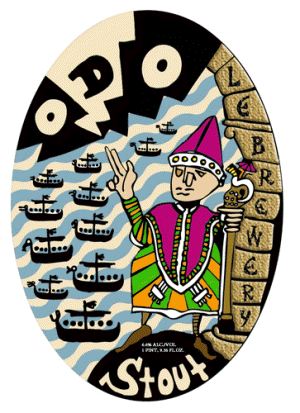 Le Brewery Odo Top Tastings 2012
ABV: 6.6%
Origin: Joué du Bois, Orne, France
Website: www.le-brewery.com
I know of several expatriate Brits involved with small breweries in France – an interesting country for beer at the moment as a new international craft brewing sensibility is supplementing and reinventing established regional styles. Steve Skews is one of those Englishmen abroad, and his outfit, named with the bilingual fusion Le Brewery, is gaining international attention.
The brewery, set up in 2001, is in Lower Normandy, a region with a strong historic connection to England of course, but these days better known for cider than beer. Steve’s label designs and names evoke the era of the Norman invasion – Odo, William the Bastard’s half brother and later Earl of Kent, was the man who, as Bishop of Bayeux, quite likely commissioned the famous tapestry.
Odo’s namesake beer is an unusual but delicious strong milk stout. Unfermentable lactose is added to the mash to give a sweet, toothy note alongside Maris Otter pale and crystal barley malt, wheat malt and roasted barley. Hops are Challenger, Goldings, Styrian Goldings and Cobb, and the beer is fermented with liquid English yeast.
Milk stout is something of an endangered style, though there are welcome signs of new interest in lactose among craft brewers. The best known traditional example, Mackeson, originated across the Channel in Hythe in Odo’s former earldom, but that’s an industrial beer that’s now thought of as an old lady’s tipple, and is about a third of the strength of Le Brewery’s example.
My 330ml bottle was bought at Drinkers Paradise, a surprisingly beer-friendly corner offie at Kentish Town West. It was lively beer, very dark brown in colour with a thick and smooth tan head, and a roasty, leathery and slightly chocolatey aroma.
The palate began dry and malty before tangy, fruity raisin and roasted coffee flavours emerged, the roast note kept well in check by an obvious sweetish milk gum quality. The finish was also lightly roasty with sultanas, black coffee and chocolate, complex leathery notes and a late whiff of smoke.
Highly recommended – including for old ladies.
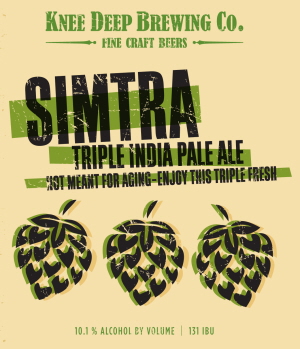 Knee Deep Simtra Triple India Pale Ale Top Tastings 2012
ABV: 11.3%
Origin: Lincoln, California, USA
Website: kneedeepbrewing.com
I asked the staff of small but outstanding specialist drinks shop Healthy Spirits, in San Francisco’s Duboce Triangle, for a recommendation of a new West Coast IPA to try and was pointed to this example from Knee Deep at Lincoln, in Placer County in the suburbs of Sacramento. I was glad I asked, as this triple IPA turned out to be a huge and complex stunner.
As its name suggests, Simtra is hopped with a blend of Simcoe and Citra, deployed in apparently enormous quantities. My example, in a bomber bottle, was warm gold, with a dense, just off-white head and a strong and slick hoppy aroma with notes of citric lime, honey and blackcurrant pastilles.
There was also that sharp, animal-like, endocrinal aroma associated with Simcoe that’s sometimes referred to indelicately as “cat pee”— but if it’s attractive in perfume, why shouldn’t it be in beer?
A richly syrupy and mouth-filling palate revealed successive layers of flavour – toffee malt, lemon, pine, liquorice, sherbert, fenugreek and tropical fruit. An obvious alcohol warmth was soothed by silky honey-like notes.
More herbal flavours like rosemary oil emerged alongside citrus on a resinous palate, with a long developing and lingering burry bitterness smoothed off again with unguent lemon and honey flavours.
Knee Deep beers first appeared in 2010 when founder and head brewer Jeremy Warren started contract brewing at Mount Tallac near Lake Tahoe. The next year, with the help of investors, he took over the defunct Beermann’s brewpub in Lincoln and since then the beers have been more widely available.
Jeremy’s nickname, the Hoptologist, makes clear where his main brewing interests lie and Simtra exhibits a notable skill with the resinous bine. It’s also an excellent demonstration that ultrahoppy beers needn’t just be about massive bitterness and aroma.
Incidentally, note the warning on the label — despite the strength, this is a beer best drunk fresh for maximum hop effect.
 Jester King Le Petit Prince Top Tastings 2012
ABV: 2.9%
Origin: Austin, Texas, USA
Website: jesterkingbrewery.com
It seems US craft beer drinkers, probably with some relief, are starting to realise there’s life below 5.5%. Session beer is one of the current buzz terms across the Atlantic, as brewers start to take up the challenge their British counterparts have long wrestled with – packing plenty of flavour and interest into the sort of gravity that won’t leave you with a headache.
Jester King, founded by brothers Jeff Stuffings and Michael Steffing in Texas hill country just outside Austin in 2010, is a noteworthy advocate for easy going beers inspired by traditional European models. It promotes itself as a farmhouse brewery, inspired by styles like Belgian saison and the bières de garde of French Flanders. But it’s rare among new craft breweries in also taking note of that often overlooked family of low gravity styles, the table beers.
Look on the edges of the beer section of any Belgian supermarket and you’ll find a small selection of low gravity (1.5%-3%) tafelbieren or bières de table, usually in 750ml screw cap bottles – Piedboeuf, from AB InBev’s Jupiler brewery, is the most common but several family owned independents are also active in the sector. Many of these beers are now bland and additive-laden, but they’re still an intriguing reminder of the days when beer was drunk throughout the day, and still thought suitable for serving to children.
Jester King’s Le Petit Prince, launched in 2011, is considerably better than a modern industrial table beer but shares something of the same aspiration to share a dining table with a simple lunch, and also offers, in the brewery’s words, “a clear, simple expression of the delightful interplay between noble hops and farmhouse yeast.”
Named after cult 1943 children’s book Le petit prince (The Little Prince) by Antoine de Saint-Exupéry, and perhaps in recollection of the family friendliness of table beer, the Texan example is brewed from organic Pilsner, two row pale and Caramunich barley malts, wheat malt and Czech Žatec and East Kent Goldings hops, perhaps with other varieties according to availability.
My sample was a cloudy blond with a good white head. A creamy, yeasty, slighty wheaty aroma had tempting notes of vanilla and spice. The attractively light and easy going palate was well balanced with a good cereal body and classic hop flavours. Though noticeably thin it was still fine enough. Light fruit from the hops came through on a chewy finish that yielded a distinct grassy noble hop hum.
I tasted the beer poured from a 750ml bottle at the Borefts Bierfestival at De Molen brewery in Bodegraven, the Netherlands, in September 2012, where it held its own impressively against a range of weird and wonderful brews at the sort of strengths you definitely wouldn’t want to serve to children.
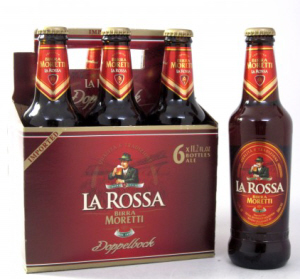 Heineken Italia Moretti La Rossa Top Tastings 2012
ABV: 7.2%
Origin: Milano, Lombardia, Italy
Website: birramoretti.com
Even before the current crop of craft brewers producing weird beers in designer bottles, Italy deserved at least a footnote in any survey of world brewing. Although more famous for its wines, there has long been a market on the peninsula for beer.
In the north Italy borders on the German speaking world: some of its territory was once under Austrian influence and communities of German speakers still exist. So unsurprisingly Italian brewers tended to follow German models when brewing took off as a major industry in the 19th century.
The big names still surviving from this period are now mainly owned by multinationals, but the occasional historic speciality has been retained. One such is La Rossa, which I’ve been looking out for since reading Michael Jackson’s writings about it – a beer with the colour of a Vienna lager but the strength of a Maibock.
It originated at the Moretti brewery, founded in Udine, in the far northeast not far from what’s now the Slovenian border, in 1859. Moretti became one of Italy’s big players, establishing its soft pale lager Birra Moretti as a national brand. The brewery was bought by Interbrew (now AB InBev) in 1989, then sold on to Heineken in 1996. The Dutch company had been active in the Italian market since 1974 when it bought the Dreher brewery in Trieste, originally an offshoot of the celebrated brewery of the same name in Wien, where Vienna lager had been perfected.
The plants in Udine and Trieste are long closed, as are several others Heineken took over, and it’s difficult to say exactly where La Rossa is now brewed. Heineken’s Italian production is allocated from a corporate headquarters in Milano between four breweries in Assemini (Sardinia), Comun Nuovo (Lombardia), Massafra (Apulia) and Pollein (Valle d’Aosta).
Nonetheless La Rossa, though filtered and pasteurised, is still a pretty good beer, as I discovered when I stumbled unexpectedly on it in the fridge at the Albion pub in London W14. This friendly pub is Good Beer Guide listed and a former local CAMRA pub of the year with a few well kept cask beers from Caledonian and Theakston – it happens to have a Heineken tie through the brewery’s ownership of Scottish & Newcastle. But it’s hardly a specialist beer haunt, and indeed the manager felt obliged to forewarn me about the beer’s strength before I bought it.
La Rossa’s rich reddish chestnut brown colour lives up to its name, with a thick foamy light beige head. A lightly nutty spiced toffee aroma has a very Germanic ring, with grassy noble hops and soft chocolate notes from the coloured malt.
The firm raisin and nut palate rapidly dries with notes of chocolate, minerally pencil lead and treacle toffee. The swallow is very smooth, setting up a dried fruit finish with an emerging hop bite and some roast.
Overall this is a big boned but smooth beer, spicy and complex enough to reward considered sipping, and surely one of the most interesting entrants in Heineken’s international portfolio of brands.
|
Cask  This pioneering new book explains what makes cask beer so special, and explores its past, present and future. Order now from CAMRA Books. Read more here. This pioneering new book explains what makes cask beer so special, and explores its past, present and future. Order now from CAMRA Books. Read more here.
London’s Best Beer  The fully updated 3rd edition of my essential award-winning guide to London’s vibrant beer scene is available now from CAMRA Books. Read more here. The fully updated 3rd edition of my essential award-winning guide to London’s vibrant beer scene is available now from CAMRA Books. Read more here.
|














